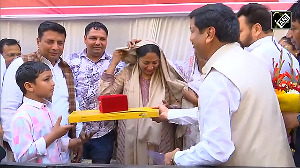 After its spiral dive last year, the Indian aviation industry noticed slight signs of improvement at the fag end of 2009 that also saw a major helicopter crash in which Andhra Pradesh Chief Minister Y S R Reddy perished and several near-miss incidents.
After its spiral dive last year, the Indian aviation industry noticed slight signs of improvement at the fag end of 2009 that also saw a major helicopter crash in which Andhra Pradesh Chief Minister Y S R Reddy perished and several near-miss incidents.
The combined losses of all airlines in 2008-09 was over a massive Rs 8,000 crore (Rs 80 billion).
Though no accidents involving scheduled carriers occurred, the year saw the Y S R tragedy. There were also several near-miss incidents, including one involving the IAF choppers carrying President Pratibha Patil and an Air India plane.
The operations of Jet Airways and Air India remained paralysed for several days by separate strikes called by their pilots in September to press for their demands.
The major dip in passenger traffic caused by the economic recession, low business traffic and high ticket prices through the year, started looking up in the last two-three months of 2009, but the yields continued to remain low.
Barring only two carriers -- IndiGo and Paramount -- all scheduled airlines continued to post huge losses. Led by Air India which was estimated to suffer a loss of about Rs 5,000 crore (Rs 50 billion) in 2008-09, Kingfisher Airlines posted a loss of Rs 1,602 crore (Rs 16.02 billion), Jet Airways-JetLite combine Rs 1,032 crore (Rs 10.32 billion), SpiceJet Rs 352.50 crore (Rs 3.525 billion) and GoAir Rs 22.5 crore (Rs 225 million).
Air India's financial troubles saw the government coming to its aid and allocating Rs 800 crore (Rs 8 billion) as the first tranche of equity infusion in the national carrier. It also approved a Jet Airways proposal to raise $400 million from foreign institutional investors.
Modernisation work at metro and non-metro airports continued, but imposition of development charges and hiking of airport charges by private airport developers at some major airports coming under criticism.
While a green signal was granted for construction of new greenfield airports at Navi Mumbai and Mopa in Goa, apart from an aerotropolis near Durgapur in West Bengal, work on these projects are likely to start in the next few months.
The pace of work on upgrading and modernisation of 35 non-metro airports slowed down due to a decline in air traffic, with only nine expected to be completed by March.
Work on another five airports is likely to be completed by 2010-end and the remaining 26 by 2012.
The hiking of airport charges and imposition of development fees at major airports like Delhi, Mumbai, Hyderabad and Bangalore, came in from criticism from various quarters, including the IATA which put Indian airports on a 'wall of shame'.
The Airports Economic Regulatory Authority (AERA), set up this year, was plagued by delays in selection of its top officers and is yet to start full-fledged monitoring and regulation of these charges and other tariffs.
The government had last year approved the FDI limits in civil aviation sector of up to 49 per cent on automatic route and up to 100 per cent for NRIs, besides up to 74 per cent for non-scheduled operators and 100 per cent for cargo, among other things.
While global fuel prices maintained a high but stable rate at $70-80 a barrel, a key factor which could have led to the airlines controlling their losses was a shift to the all-economy, no-frill model, with Jet Airways launching its second subsidiary, Jet Konnect.
Air India announced plans to follow suit by converting some planes to all economy configurations, but that is yet to see the light of the day.
Industry experts said a shift to the no-frill model by the large carriers would allow them to develop a more competitive cost structure, thereby checking their losses.
The International Air Transport Association (IATA) predicted that the global airline industry would halve its net losses to $5.6 billion in 2010 from $11 billion this year, with carriers in Asia-Pacific experiencing a 'dramatic improvement' in their financial bottomline.
Noting that the economies of India, China and Brazil had started showing marked growth, it said the Asia-Pacific carriers were expected to show the 'biggest reduction in average losses' due to an upturn in yields and traffic.
While the lack of infrastructure continued to plague airline operations, efforts were on to modernise a large number of airports, including non-metro airports, by the Airports Authority of India and private developers.
Government, in the meantime, refused to approve an AAI proposal to issue infrastructure bonds to raise about Rs 5,000 crore (Rs 50 billion) from the market for the modernisation of airports.






 © 2025
© 2025